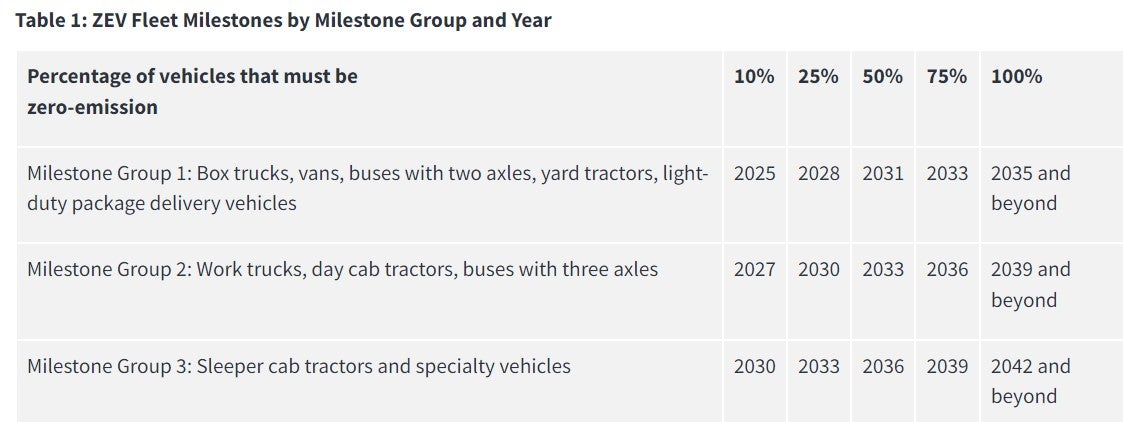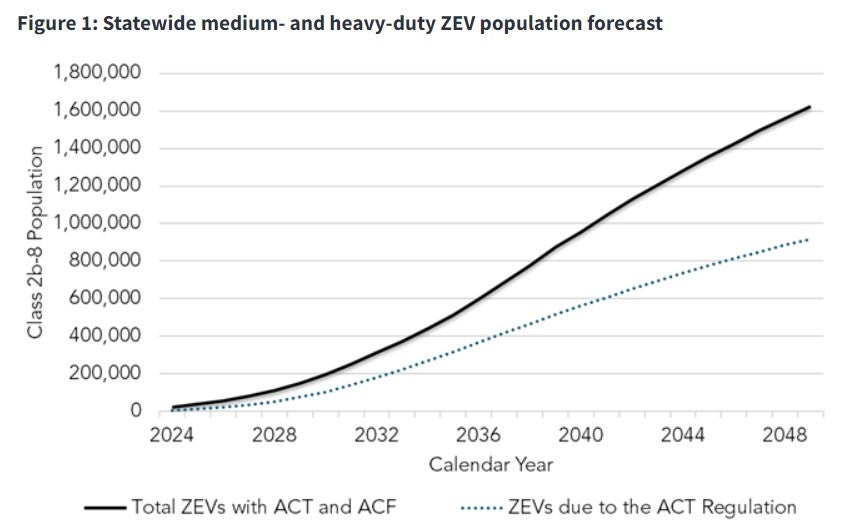Freight News:
California OKs Advanced Clean Fleet rule; here’s a summary of it
On a unanimous vote, the Advanced Clean Fleet rule has been adopted in California.
The sweeping rule was approved Friday by the California Air Resources Board after several years of proposals, hearings, and a combination of industry pushback and acceptance as equipment designed to meet the state’s requirements for a zero-emission-vehicle (ZEV) fleet made its way to the market. Purchases of that equipment got frequent attention.
CARB’s approval set off the usual rush of press releases hitting journalist mailboxes.
American Trucking Associations President Chris Spear decried the actions of “an unelected board [forcing] trucking companies to buy zero-emission trucks.”
“Fleets are just beginning to understand what it takes to successfully operate these trucks, but what they have learned so far is they are significantly more expensive, charging and refueling infrastructure is nonexistent, and ZEVs are not necessarily a one-for-one replacement — meaning more trucks will be needed on California roads to move the same amount of freight,” Spear said.
On the other side of the divide, Katelyn Roedner Sutter, the California director of the Environmental Defense Fund, said the ACF rule “will have significant positive health impacts and will help provide benefits for residents in communities exposed to high truck traffic. The Advanced Clean Fleets Rule will speed the transition to zero-emission trucks which is one of the most powerful opportunities to reduce climate pollution, address equity, improve our health and lower the cost of operating these trucks.”
But beyond the rhetoric, what’s actually in the ACF?
The ACF is aimed at the buyers of trucks; the Advanced Clean Trucks rule is targeted at the companies that make them. The ACT was approved in March 2021.
ACF affects three primary categories of fleets:
- Drayage trucks.
- Government fleets.
- “High priority fleets.” CARB defines these as companies that “own, operate or direct” at least one vehicle in the state, and that have $50 million or more in gross annual revenues or “own, operate or have common ownership or control” of 50 or more vehicles in California. The weight of the vehicles that are affected is a gross weight of 8,500 pounds or more.
Drayage
There is little doubt that the biggest short-term impact from ACF comes from its rule on drayage trucks. Starting Jan. 1 of next year, only ZEVs can register in the CARB’s drayage registry. Vehicles with internal combustion engines (ICE) that are on the road now can continue to operate through their “useful life.” Those limits mean that when a drayage truck hits 800,000 miles, it can no longer be listed in the registry of drayage vehicles. The alternative is if it reaches 18 years after its model year, even if it has not reached 800,000 miles.
High-priority fleets
This one can be confusing. It could be read as being similar to drayage, where no new ICE vehicles can be registered at the start of 2024.
That is true — up to a point. Part of the ACF rule says fleets can only purchase ZEVs starting in January 2024 and must take ICE trucks out of their fleets by the start of 2025.
But the ability to replace an ICE vehicle in a high-priority fleet after Jan. 1 is convoluted. One part of the ACF says that to keep in compliance, a fleet must have “no ICE vehicles added on or after January 1, 2024, unless … .” And it’s the “unless” part that has several twists. For example, if the ICE vehicle was ordered before the end of this year, it’s OK to add it to a fleet. There are other exemptions that would allow ICE purchases if a variety of targets are hit. It’s complex and will keep compliance officers busy.
Since not all fleets are going full ZEV in 2024, what will govern the transition to 100% ZEVs is the “Milestones” schedule. It calls for a graduated move to ZEVs depending on the classification of the truck. So fleets of sleeper cab tractors need only be 10% ZEV by 2030. This chart is taken from CARB’s website.

That means a current fleet could buy a new ICE vehicle now and maybe past Jan. 1, 2024, (if it meets the exemption criteria), but it could also buy a greater quantity of ZEVs as long as the end figure reaches 10% ZEV by 2030. For that group of trucks, the percentage rises to 25% by 2033, 50% by 2036, 75% by 2039 and 100% by 2042 and beyond.
The difference in the Milestones target of 2042 for Class 8 tractors can be confusing because an amended proposal by CARB requires that no new vehicles delivered into California after 2036 be anything other than a ZEV. (It was reduced from 2040.) It isn’t clear whether a fleet could buy a used ICE Class 8 tractor after that date as long as it stays within its Milestone target.
Government rules
The key thing to know is that there are Milestone targets here as well. The targets are the same as for the high-priority fleets. As far as the purchase requirements separate from the Milestones, government fleets must have 50% ZEV purchases starting next year and 100% ZEV purchases by 2027. A fleet of fewer than 10 vehicles can wait until 2027 before being required to buy ZEV-only vehicles.
Useful life
The same useful life rules that are impacting drayage will govern the retirement of older vehicles in high-priority fleets. A truck must be removed from the system if it reaches the earlier of 18 years or 800,000 miles, or a minimum of 13 years if the truck has more than 800,000 miles. There are no such rules for state and local government fleets.
What if the infrastructure isn’t ready?
In the latest round of revisions from earlier this year, CARB observers said they believed the biggest changes involved permissible delays if charging or other refueling infrastructure — like hydrogen — wasn’t available. There had been a one-year delay in mandated ZEV purchases in the prior regulation; that has been increased to two years.
The latest revision also added a similar compliance extension if a ZEV simply could not be obtained. In one example that CARB might have accepted some of the concerns about vehicle availability, it increased to 180 days the amount of time a buyer that had its ZEV purchase canceled by the supplier has to secure a substitute. That number had been 90 days.
Getting to 100% ZEVs
CARB staff estimates that, of the 1.8 million medium- and heavy-duty vehicles operating daily in California, 532,000 will be subject to ACF fleet requirements. On its website, CARB estimates that 12% of all Class 2B-3 vehicles will be affected, 52% of Class 4-8 vocational vehicles will fall under the rule, and 67% of Class 7-8 tractors.
But with the ACF and ACT rule together limiting the ability of ICE vehicles to be sold into the state, truck owners not directly affected by the rule whose vehicles simply wear out due to age won’t find the marketplace providing them an opportunity to buy a new ICE truck.

What happens there doesn’t stay there …
Six states that have said they will follow California’s lead in adopting ACF rules: New York, New Jersey, Oregon, Massachusetts, Washington and Vermont.
More articles by John Kingston
TriumphPay network’s growth slows by some measures, stronger by others
C.H. Robinson’s Q1 was weak; April’s freight market was no better
CTA, OOIDA target Gonzalez statements in latest filings
The post California OKs Advanced Clean Fleet rule; here’s a summary of it appeared first on FreightWaves.
Source: freightwaves - California OKs Advanced Clean Fleet rule; here’s a summary of it
Editor: John Kingston